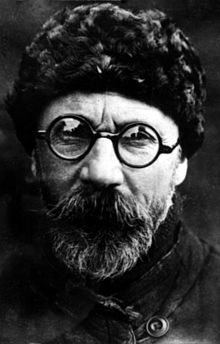Leonid Kulik
This article needs additional citations for verification. (May 2007) |
Leonid Kulik | |
|---|---|
 | |
| Born | 19 August 1883 |
| Died | 24 April 1942 (aged 58) |
| Nationality | Russian |
| Known for | meteorites, discovery of Tunguska blast site |
| Scientific career | |
| Fields | Mineralogy |
Leonid Alekseyevich Kulik (Russian: Леонид Алексеевич Кулик, 19 August 1883 – 14 April 1942) was a Russian mineralogist who is noted for his research into meteorites.
He was born in Tartu,[1] Estonia, and was educated at the Imperial Forestry Institute in Saint Petersburg and the Kazan University. He served in the Russian military during the Russo-Japanese War, then spent some time in jail for revolutionary political activities. He then served with the Russian military during World War I.
Following the war he became an instructor, teaching mineralogy in Tomsk. In 1920 he was offered a job at the Mineralogical Museum in St. Petersburg.
In 1927, he led the first Soviet research expedition to investigate the Tunguska event,[2][3] the largest impact event in recorded history, which had occurred on 30 June 1908. He made a reconnaissance trip to the region, and interviewed local witnesses. He circled the region where the trees had been felled and became convinced that they were all turned with their roots to the center. However he did not find any meteorite fragments from the impact.
During World War II he again fought for his country, this time in a paramilitary militia. He was captured by the German army and died in a prisoner of war camp of typhus.[4]
Honors
- Asteroid 2794 Kulik is named for him.
- The crater Kulik on the Moon is named after him.
References
- ^ Hockey, Thomas (2009). The Biographical Encyclopedia of Astronomers. Springer Publishing. ISBN 978-0-387-31022-0. Retrieved August 22, 2012.
- ^ Siberian Apocalypse (H2--History Channel; Nov. 2, 2011)
- ^ In Siberia in 1908 a huge explosion came out of nowhere
- ^ http://www.unmuseum.org/kulik.htm
